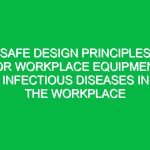In today’s rapidly evolving industrial landscape, the importance of designing for easy maintenance and safety cannot be overstated. This concept is not merely a guideline; it serves as a foundation for creating environments that prioritize employee well-being while ensuring operational efficiency. In the realm of Health, Safety, and Environment (HSE), effective design can significantly mitigate risks, enhance productivity, and extend the lifespan of equipment. This article will explore the nuances of this critical aspect, delve into potential hazards, outline necessary safety precautions, and touch on relevant regulations and standards.
Understanding the Importance of Designing for Easy Maintenance and Safety
Designing for easy maintenance and safety refers to the strategic approach of creating systems, equipment, and environments that are not only user-friendly but also prioritize safety and ease of upkeep. This approach is particularly relevant in sectors like manufacturing, construction, and healthcare, where hazards are prevalent, and the stakes are high. A well-designed workspace can enhance safety by making it easier for workers to perform their tasks without unnecessary risk. For instance, in a factory setting, machines that are easy to access for maintenance reduce the chances of accidents occurring during repair work.
Moreover, when maintenance is simplified, downtime is minimized, leading to increased productivity. Organizations that embrace this design philosophy often report lower injury rates and reduced costs related to accidents and equipment failures. This dual focus on safety and maintenance contributes significantly to a company’s overall operational excellence, demonstrating that investing in thoughtful design pays off in both the short and long term.
Identifying Potential Hazards and Risks
Designing for easy maintenance and safety involves understanding the various hazards and risks that can arise in the workplace. These can range from physical dangers to ergonomic issues and environmental concerns.
Physical Hazards
Physical hazards include any condition that poses a risk of injury or harm to employees. For instance, machinery with sharp edges, unguarded moving parts, or inadequate safety features can lead to severe injuries. Inadequate lighting in workspaces can increase the likelihood of accidents, as workers may not see potential hazards in their path.
Chemical Hazards
In industries that handle hazardous materials, the risk of chemical exposure is a significant concern. Poorly designed storage areas for chemicals can lead to spills, leaks, or improper handling, resulting in health risks for employees. Implementing features such as secondary containment systems and proper labeling is crucial for enhancing safety.
Ergonomic Hazards
Ergonomic risks arise from poor workstation design that leads to repetitive strain injuries or musculoskeletal disorders. Desks that are too high or low, tools that are difficult to grip, and inadequate seating can contribute to discomfort and long-term health issues. Designing workstations that allow for adjustability and comfort can greatly minimize these risks.
Environmental Hazards
Environmental hazards include factors like noise, temperature extremes, and inadequate ventilation. For instance, a manufacturing facility that generates high noise levels without proper soundproofing can lead to hearing loss over time. Similarly, workplaces that lack adequate ventilation can expose employees to harmful fumes and pollutants.
Best Practices for Designing for Easy Maintenance and Safety
To effectively design for easy maintenance and safety, organizations should adopt a set of best practices that focus on hazard mitigation and user-friendly designs.
Conduct Thorough Risk Assessments
Before implementing any design changes, it’s essential to conduct a comprehensive risk assessment. This process involves evaluating existing hazards and identifying potential risks associated with new designs. Engaging employees in this assessment can provide valuable insights, as they are often the first to recognize potential issues in their work environment.
Prioritize Accessibility
One of the key principles in designing for easy maintenance is ensuring that all equipment and systems are easily accessible for maintenance personnel. This can include placing machinery in well-lit areas, ensuring that maintenance panels are easily removable, and providing adequate space for workers to maneuver safely. For example, in a hospital setting, ensuring that medical equipment is easily accessible can facilitate timely maintenance, ultimately improving patient care.
Implement Safety Features
Integrating safety features into designs is vital. This includes installing guards on machines, using non-slip surfaces in high-traffic areas, and implementing emergency shut-off switches. Regularly reviewing and updating these safety features can help ensure that they remain effective as equipment and environments change.
Incorporate Training and Awareness Programs
Designing for easy maintenance and safety goes beyond physical structures and systems. Employee training is crucial. Regular workshops and training sessions can help employees understand the importance of safety protocols and how to operate equipment correctly. For example, a manufacturing company implemented a comprehensive training program that significantly reduced workplace injuries over a year. Employees learned not only how to use the equipment safely but also how to conduct regular maintenance checks.
Safety Precautions for Identified Hazards
Once hazards are identified, it’s crucial to implement safety precautions tailored to each specific risk. Here are some actionable strategies:
Physical Hazard Precautions
To address physical hazards, ensure that all machinery is equipped with proper guards and emergency stop buttons. Regular inspections should be conducted to ensure these safety features are operational. Additionally, training employees on how to safely interact with machinery can reduce accidents.
Chemical Hazard Precautions
For environments dealing with chemical hazards, it is essential to establish standard operating procedures for chemical handling. This includes using appropriate personal protective equipment (PPE), such as gloves and masks, and ensuring that Material Safety Data Sheets (MSDS) are readily available. Implementing spill response protocols can also mitigate risks associated with chemical spills.
Ergonomic Hazard Precautions
To combat ergonomic hazards, organizations should invest in adjustable workstations that accommodate a range of worker heights and preferences. Providing tools designed to reduce strain, such as ergonomic hand tools, can also be beneficial. Regular breaks and stretches should be encouraged to alleviate physical stress.
Environmental Hazard Precautions
Addressing environmental hazards involves investing in soundproofing materials in noisy areas and ensuring proper ventilation systems are in place. Regular monitoring of air quality can help maintain a safe working environment. In industries with high noise levels, providing hearing protection should also be a standard practice.
Regulations and Standards Governing Designing for Easy Maintenance and Safety
Implementing effective designs for easy maintenance and safety is not just a best practice; it is often mandated by regulations and standards. Various organizations have established guidelines to ensure workplace safety. The Occupational Safety and Health Administration (OSHA) in the United States provides comprehensive regulations that govern workplace safety and health. Similarly, the National Institute for Occupational Safety and Health (NIOSH) offers research and recommendations for improving workplace safety.
Internationally, the ISO 45001 standard focuses on occupational health and safety management systems, providing a framework for organizations to improve employee safety, reduce workplace risks, and create better, safer working conditions. It emphasizes the importance of continual improvement and employee involvement in safety management.
Conclusion
Designing for easy maintenance and safety is a multifaceted approach that significantly impacts the Health, Safety, and Environment domain. By understanding potential hazards, implementing best practices, and adhering to relevant regulations, organizations can create safer, more efficient work environments. This endeavor not only protects employees but also enhances productivity and operational reliability. As we move forward in an increasingly complex industrial landscape, prioritizing safety in design will remain a cornerstone of effective HSE management.
In the end, embracing a culture that values safety and maintenance in design is more than a regulatory obligation; it’s a commitment to the well-being of every employee. The benefits are clear: safer workplaces, happier employees, and improved bottom lines. Let’s continue to advocate for designs that prioritize safety and ease of maintenance, ensuring that every worker can perform their tasks with confidence and security.


